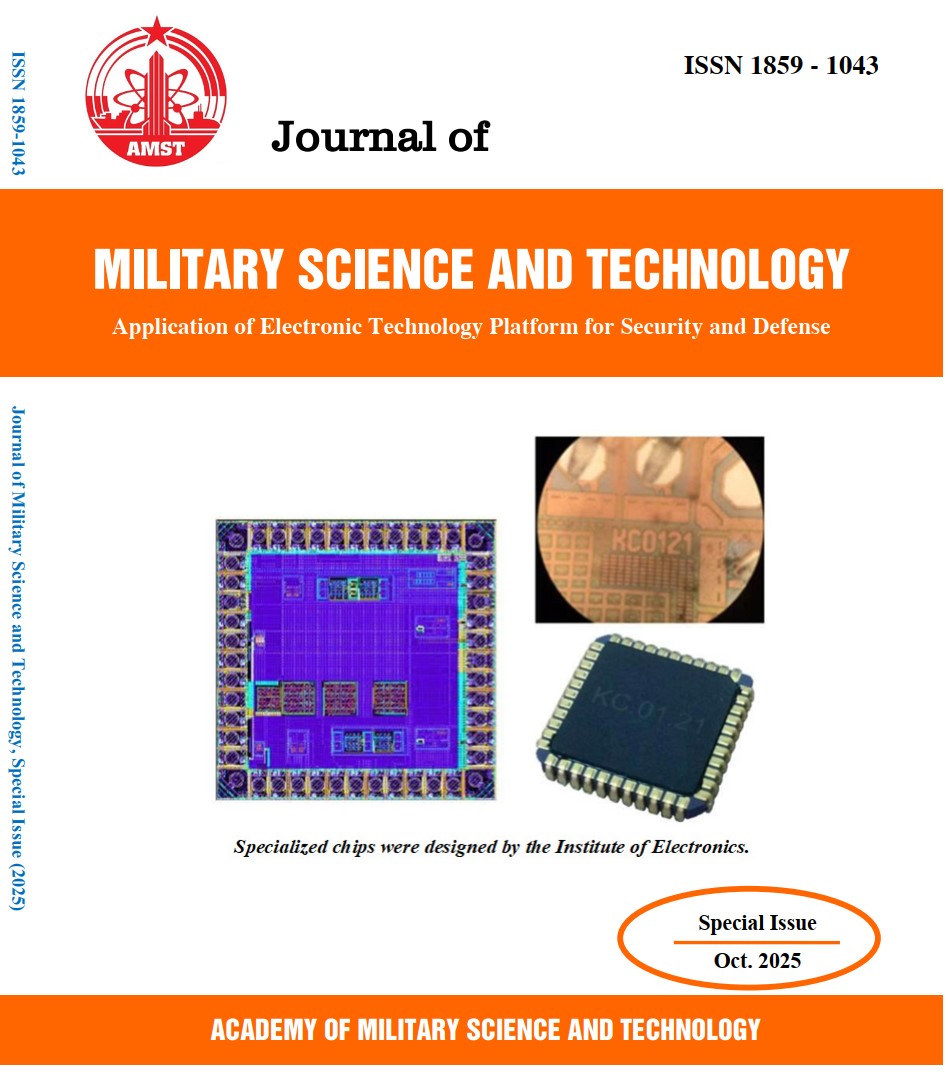EB-UNet++: An enhanced crack segmentation network combining EfficientNet-B2 and UNet++ with boundary extraction module
394 viewsDOI:
https://doi.org/10.54939/1859-1043.j.mst.IITE.2025.148-159Keywords:
Pavement crack detection; Crack segmentation; Boundary extraction module (BEM); Road surface inspection; Multi-scale feature extraction.Abstract
Pavement crack detection is a crucial task in intelligent transportation systems and infrastructure maintenance. However, accurate segmentation of cracks remains challenging due to their irregular shapes, low contrast against the background, and varying lighting or surface conditions. In this study, we propose EB-UNet++, a novel deep learning architecture designed to enhance crack segmentation performance. EB-UNet++ integrates the powerful feature encoding capabilities of EfficientNet-B2 into the UNet++ encoder structure, enabling more efficient and robust multi-scale feature extraction. To further refine the crack boundaries and suppress false detections, we incorporate a Boundary Extraction Module into the network. Experimental results on benchmark pavement crack datasets demonstrate that EB-UNet++ outperforms several state-of-the-art models in both segmentation accuracy and boundary delineation, achieving higher IoU and F1-scores. The proposed architecture shows strong potential for practical deployment and scalability in automated road inspection and infrastructure monitoring systems.
References
[1]. Badrinarayanan, Vijay, Alex Kendall, and Roberto Cipolla. “SegNet: A Deep Convolutional Encoder-Decoder Architecture for Image Segmentation.” IEEE Transactions on Pattern Analysis and Machine Intelligence, 39, 2481–2495 (2015). DOI: https://doi.org/10.1109/TPAMI.2016.2644615
[2]. Chen et al. “A multiscale enhanced pavement crack segmentation network coupling spectral and spatial information of UAV hyperspectral imagery.” Int. J. Appl. Earth Obs. Geoinformation, 128, 103772 (2024). DOI: https://doi.org/10.1016/j.jag.2024.103772
[3]. Dai et al. “Deformable Convolutional Networks.” 2017 IEEE International Conference on Computer Vision (ICCV), 764–773 (2017). DOI: https://doi.org/10.1109/ICCV.2017.89
[4]. Goo, June Moh, Xenios Milidonis, Alessandro Artusi, Jan Boehm, and Carlo Ciliberto. “Hybrid-Segmentor: A Hybrid Approach to Automated Fine-Grained Crack Segmentation in Civil Infrastructure.” ArXiv abs/2409.02866 (2024). DOI: https://doi.org/10.36227/techrxiv.170775714.48894818/v1
[5]. Goo, June Moh et al. “CrackVision12K.” University College London. Dataset. (2024). https://doi.org/10.5522/04/26946472.v1
[6]. Han, Chengjia, Handuo Yang, and Yaowen Yang. “Enhancing pixel-level crack segmentation with visual mamba and convolutional networks.” Automation in Construction (2024). DOI: https://doi.org/10.1016/j.autcon.2024.105770
[7]. Hu, Xiaopeng et al. “BBCNet: Boundary-body coherence network with adaptive self-attention distillation for enhanced crack segmentation.” Digit. Signal Process., 162, 105148 (2025). DOI: https://doi.org/10.1016/j.dsp.2025.105148
[8]. Huyan, Ju, Wei Li, Susan L. Tighe, Zhengchao Xu, and Junzhi Zhai. “CrackU-net: A novel deep convolutional neural network for pixelwise pavement crack detection.” Structural Control and Health Monitoring, 27 (2020). DOI: https://doi.org/10.1002/stc.2551
[9]. Ji, Honggeun, Jina Kim, Syjung Hwang, and Eunil Park. “Automated Crack Detection via Semantic Segmentation Approaches Using Advanced U-Net Architecture.” Intelligent Automation & Soft Computing (2022). DOI: https://doi.org/10.32604/iasc.2022.024405
[10]. Liu, Gaoyang, Wei Ding, Jian-Hua Shu, Alfred Strauss, and Yuan-yu Duan. “Two-Stream Boundary-Aware Neural Network for Concrete Crack Segmentation and Quantification.” Structural Control and Health Monitoring (2023). DOI: https://doi.org/10.1155/2023/3301106
[11]. Liu, Huajun, Xiangyu Miao, Christoph Mertz, Chengzhong Xu, and Hui Kong. “CrackFormer: Transformer Network for Fine-Grained Crack Detection.” 2021 IEEE/CVF International Conference on Computer Vision (ICCV), 3763–3772 (2021). DOI: https://doi.org/10.1109/ICCV48922.2021.00376
[12]. Lin, Qing Huo, Wei Li, Xiangpan Zheng, Haoyi Fan, and Zuoyong Li. “DeepCrackAT: An effective crack segmentation framework based on learning multi-scale crack features.” Eng. Appl. Artif. Intell., 126, 106876 (2023). DOI: https://doi.org/10.1016/j.engappai.2023.106876
[13]. Liu, Yahui, Jian Yao, Xiaohu Lu, Renping Xie, and Li Li. “DeepCrack: A deep hierarchical feature learning architecture for crack segmentation.” Neurocomputing, 338, 139–153 (2019). DOI: https://doi.org/10.1016/j.neucom.2019.01.036
[14]. Mehta, Vedant. “Towards Real-Time Polyp Segmentation During Colonoscopy Using an EfficientNet-Based UNet Architecture.” 2023 IEEE 23rd International Conference on Bioinformatics and Bioengineering (BIBE), 447–451 (2023). DOI: https://doi.org/10.1109/BIBE60311.2023.00079
[15]. Pham, Thang Quoc, Thai Hoang Le, Khai Dinh Lai, Dat Quoc Ngo, Tan Van Pham, Quang Hua, Khang Le, Huyen Le, and Tuyen Nguyen. “CAAF-ResUNet: Adaptive Attention Fusion with Boundary-Aware Loss for Lung Nodule Segmentation.” Medicina, 61 (2025). DOI: https://doi.org/10.3390/medicina61071126
[16]. Ronneberger, Olaf, Philipp Fischer, and Thomas Brox. “U-Net: Convolutional Networks for Biomedical Image Segmentation.” ArXiv abs/1505.04597 (2015). DOI: https://doi.org/10.1007/978-3-319-24574-4_28
[17]. Ren, Yupeng, Jisheng Huang, Zhiyou Hong, Wei Lu, J. Yin, Lejun Zou, and Xiaohua Shen. “Image-based concrete crack detection in tunnels using deep fully convolutional networks.” Construction and Building Materials, 234, 117367 (2020). DOI: https://doi.org/10.1016/j.conbuildmat.2019.117367
[18]. Shelhamer, Evan, Jonathan Long, and Trevor Darrell. “Fully convolutional networks for semantic segmentation.” 2015 IEEE Conference on Computer Vision and Pattern Recognition (CVPR), 3431–3440 (2014).
[19]. Shen, Aoran, Ruxin Chen, Yueze Zhu, and Ruohan Hu. “Segmentation of Multi-Organ Functional Tissue Units Using UNet-EfficientNet-B8.” Proceedings of the 2023 4th International Symposium on Artificial Intelligence for Medicine Science (2023). DOI: https://doi.org/10.1145/3644116.3644158
[20]. Tan, Mingxing, and Quoc V. Le. “EfficientNet: Rethinking Model Scaling for Convolutional Neural Networks.” ArXiv abs/1905.11946 (2019).
[21]. Tao, Huaqi, Bing Liu, Jinqiang Cui, and Hong Zhang. “A Convolutional-Transformer Network for Crack Segmentation with Boundary Awareness.” 2023 IEEE International Conference on Image Processing (ICIP), 86–90 (2023). DOI: https://doi.org/10.1109/ICIP49359.2023.10222276
[22]. Zhao, Fan, Yu Chao, and Linyun Li. “A Crack Segmentation Model Combining Morphological Network and Multiple Loss Mechanism.” Sensors (Basel, Switzerland), 23 (2023). DOI: https://doi.org/10.3390/s23031127
[23]. Zhou, Yang, Raza Ali, Norrima Binti Mokhtar, Sulaiman Wadi Harun, and Masahiro Iwahashi. “MixSegNet: A Novel Crack Segmentation Network Combining CNN and Transformer.” IEEE Access, 12, 111535–111545 (2024). DOI: https://doi.org/10.1109/ACCESS.2024.3438112
[24]. Zhou, Zongwei, Md Mahfuzur Rahman Siddiquee, Nima Tajbakhsh, and Jianming Liang. “UNet++: A Nested U-Net Architecture for Medical Image Segmentation.” Deep Learning in Medical Image Analysis and Multimodal Learning for Clinical Decision Support, 11045, 3–11 (2018). DOI: https://doi.org/10.1007/978-3-030-00889-5_1







